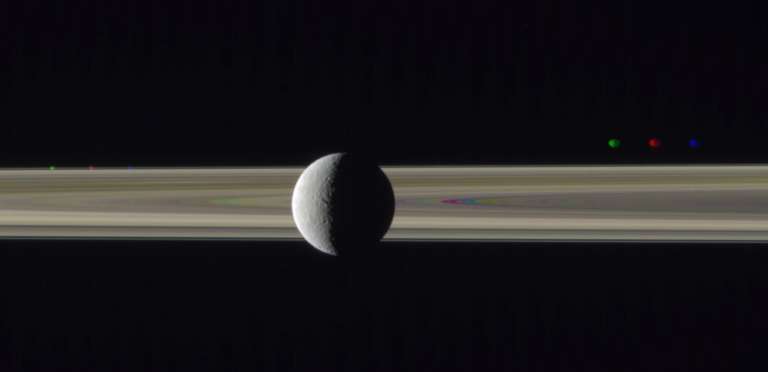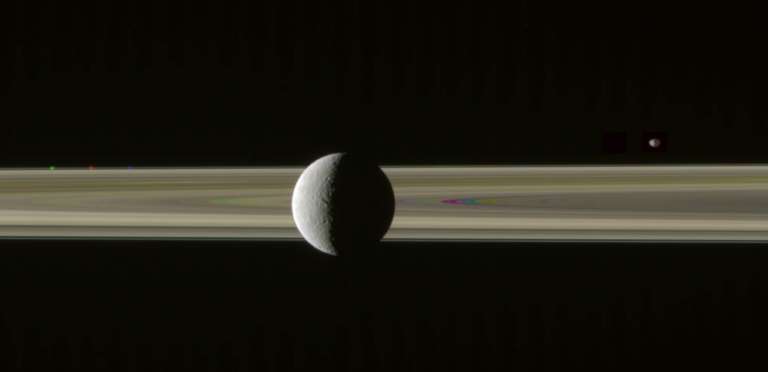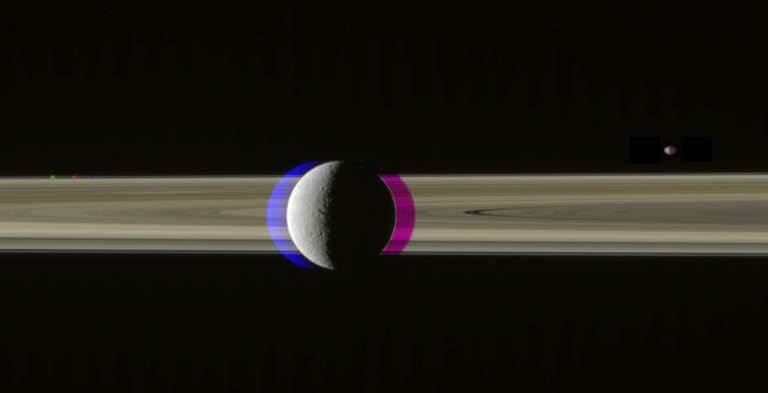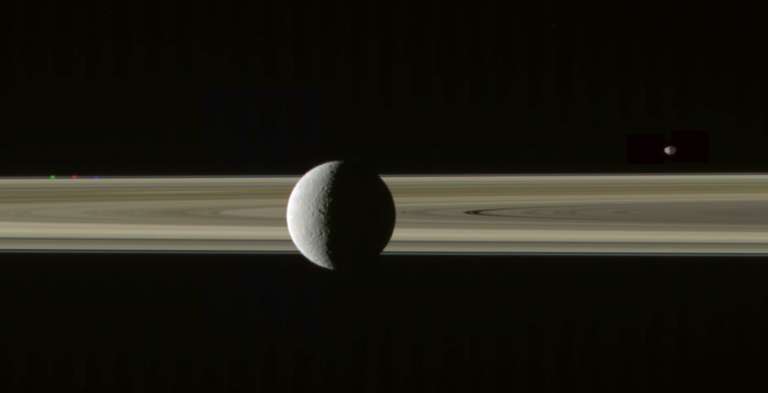Emily Lakdawalla • Apr 06, 2010
Pretty picture: Rhea, rings, and two little moons
Here's a lovely picture whose components came down from Cassini a few days ago. We're looking at Saturn's second-biggest moon, Rhea, sitting in front of the sunlit rings, with two little moons visible in the background: Prometheus nestled on the top edge of the rings on the left, and Janus poised above the rings on the right.

The image was not all that easy to put together. To make an RGB color composite from Cassini (or any other images), you just grab three photos taken through different filters, align them on the target (in this case, Rhea), and then drop each of the three photos into red, green, and blue channels of a color picture. Here's what happened when I tried to do that:

What happened? Rhea looks fine, but there's rainbow banding in the rings, and the two moons in the background appear three times, once green, once red, and once blue.
The problem, of course, is that everything in the Saturn system is in motion, including Cassini, and time passes between each of the three filtered images used to make this observation. Cassini's pointed at Rhea, keeping it in the center of the frame, but in the meantime, Cassini's perspective is shifting, causing the rings and moons to appear to move. Sometimes, you can pretend this isn't happening for the rings and you get decent color results. But there happens to be a dark gap in the rings right behind Rhea, which is visually interesting, but which causes issues with the alignment of the color channels.
First things first. Dealing with Janus is super duper easy, since it's sitting on black space. I just cut out Janus in the green and blue channels and align them with the red channel. That leaves holes in the green and blue channels where I cut out Janus. No big deal; I just paint in the holes with black. Here's what I get.

So this image is now a bit fictional. We're showing Rhea and Janus in the relative positions that they took at the precise time that Cassini photographed the pair through its red filter, but I had to fudge the green and blue filter images to make this view.
I can't do quite the same thing for Prometheus. I can cut Prometheus out but the holes I'll leave behind in the green and blue channels can't be filled with black, they need to be filled with rings. But I don't have a "paint in rings" tool! I'll need to carefully copy a piece of rings to cover up the holes left for Prometheus. But I think I will wait to do that until after I have dealt with the alignment problem in the rings. That's going to take some creativity and a lot more fudging.
Since Rhea and Janus look fine, I'm going to copy them out of the document into a separate layer for safe keeping. Then I'll align the channels on the rings. Here's what I get.

Your first impression of this version may be that it's worse than the previous one because of the glaring color stripes around Rhea. Those are places in the blue and green channels where Rhea covered up bits of the rings. (Why, you may ask, does the misalignment in the blue channel cause a blue ghost but the misalignment in the green channel cause a magenta ghost? The rings are covered with bright pixels of sunlit icy moon in the blue channel; where things are brighter in the blue channel but darker in the other channels, you get something that looks blue. But in the green channel, the rings are covered by dark nighttime moon. Where things are dark in the green channel but brighter in red and blue channels, you get what happens when you mix red and blue light: magenta pixels.) To fix this problem, I need to paint in some rings in the blue and green channels to cover up the gaps. How am I going to do that? Sadly, neither Photoshop or GIMP has a magic ring-painting paintbrush.
Fortunately, I have a place to go to find the right bits of rings. Cassini took a whole long series of observations through red, green, and blue channels, so I just need to go find green and blue filter images that contain those bits of the rings I'm missing. The green and blue filter images from just before and after the sequence that I'm working with do nicely. I copy and paste the relevant ring bits, and here's where I stand.

We're almost there! All that's left is to fix Prometheus. I do it basically the same way I fixed the rings around Rhea: I move the green and blue channel images of Prometheus to align with the red channel, then I paint in some rings to fill in the gap. Because Prometheus is sitting on top a fairly uncomplicated bit of rings, it works to copy and paste my bit of ring fill from an adjacent bit of rings within the same image rather than having to go find a bit of rings in a different Cassini photo.

How "real" is this image? It is certainly substantially processed. But one thing I have been careful to do is not to perform any major alterations to the red channel. So we are still seeing Rhea, Janus, and the rings as they appeared at the moment that the red-filter image was taken. But the green- and blue-filter images were taken from different times (after and before the red-filter image, respectively), and they have been doctored with parts of green- and blue-filter images taken at other different times.
There was a total of 27 images in the set, taken cyclically through red, green, and blue filters. So, if you had a few hours to kill, you could repeat the above operation 27 times and make a lovely full-color animation of the relative motions of these three moons and the rings. That is actually something I would like to do, but I am going to wait to expend that much effort until I can work with the calibrated, archived data. For this particular set, that means waiting just about a year, until the April 1, 2011 data release. However, there were other, similarly cool red-green-blue animations taken in December of 2009 or maybe before; we'll see that data in the October 2010 data release. Someone remind me to spend a day making a pretty full-color animation this October!
Support our core enterprises
Your support powers our mission to explore worlds, find life, and defend Earth. You make all the difference when you make a gift. Give today!
Donate

 Explore Worlds
Explore Worlds Find Life
Find Life Defend Earth
Defend Earth

